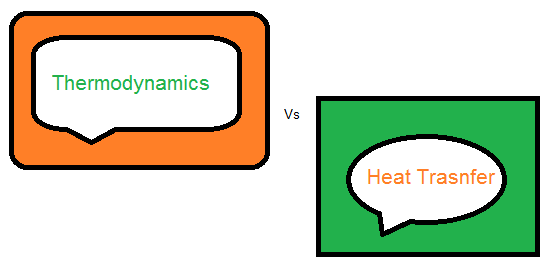Thermodynamics is a way to learn the behavior of nature. Heat transfer is one of the characteristics of nature in which heat flows from one object to another object because of temperature differences. Thermodynamics and Heat Transfer both are part of thermal engineering and each one has its own meaning and importance. Both deal with heat and energy then, one might ask, what is the real difference between the two subjects? i.e. Thermodynamics and Heat Transfer
Thermodynamics:
It deals with the amount of energy in the form of heat or work during a process and only considers the end states in equilibrium. It will not give information about how long it will take to reach the final state of equilibrium. While on the other hand,
Heat Transfer:
deals with the rate of energy transfer. thus, it gives an idea of how long a heat transfer will occur if the heat transfer is transient in nature. The steady-state heat transfer is the condition where the change in the temperature is constant throughout the system with respect to time. Heat transfer deals with time and nonequilibrium phenomena. Heat can only transfer when there is a temperature gradient that exists in a body and which is an indication of nonequilibrium phenomena.
In short, Thermodynamics gives “Why” a process will occur and Heat Transfer will tell, “How” a process will occur when there is a concern about the transfer of heat.
To support all these arguments, Thermodynamics uses the following laws,
- Zeroth Law of Thermodynamics (defines the temperature)
- The first law of Thermodynamics (defines internal energy)
- Second Law of Thermodynamics (defines entropy)
- Third Law of Thermodynamics (limits the lowest temperature attainable)
While Heat Transfer uses,
- Fourier’s Law (Heat conduction)
- Newtons Law of Cooling (Heat convection)
- Planck’s Law (Thermal Radiation)
- Stephan Boltzmann Law (Thermal Radiation)
- Wein’s Law (Thermal Radiation)
- Kirchoff’s Law (Thermal Radiation)
- Lambert’s Law (Thermal Radiation)
Learn more about such important questions to be asked in Mechanical Engineering Interview.


[…] whereas ‘auto-ignition temperature’ does not require a source of heat. This is the difference between flash point and auto-ignition temperature. While ‘Flash Point’ depends on the […]
[…] the temperature distribution within a system does not change with time. This means that the rate of heat transfer into a system is equal to the rate of heat transfer out of the system, resulting in a constant […]